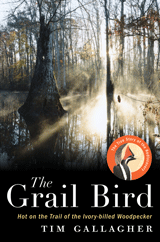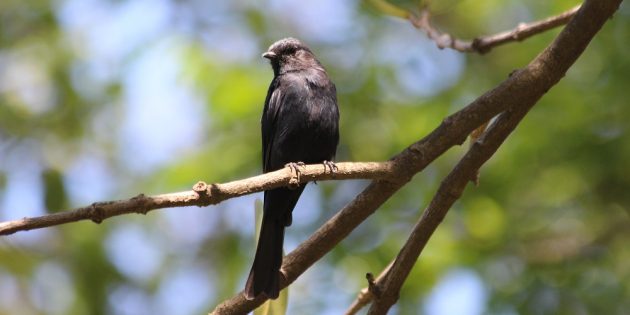 Tim Gallagher’s The Grail Bird is the definitive narrative of one of the most exciting ornithological discoveries in recent U.S. history. Yes, that’s right — I’m talking about the identification of living Ivory-billed Woodpeckers in an Arkansas bottomland swamp. What other bird story has inspired such passion, delight, and, most important, media attention in the last 50 years? The revelation that tales of this charismatic Campephilus woodpecker’s extinction were slightly exaggerated rocked not just the birding community, but the nation at large.
Tim Gallagher’s The Grail Bird is the definitive narrative of one of the most exciting ornithological discoveries in recent U.S. history. Yes, that’s right — I’m talking about the identification of living Ivory-billed Woodpeckers in an Arkansas bottomland swamp. What other bird story has inspired such passion, delight, and, most important, media attention in the last 50 years? The revelation that tales of this charismatic Campephilus woodpecker’s extinction were slightly exaggerated rocked not just the birding community, but the nation at large.The mass media coverage of this discovery initially dissuaded me from reading The Grail Bird. Not only did all the major newspapers and magazines herald the ivory-bill’s return, but a lot of my favorite blogs also commented on the news in painstaking detail, each one sharing and interpreting different aspects. I even touched on the tale on this site. However, you can’t get any closer to the story than this book, since it was written by one of its main characters.
Tim Gallagher is a well-known writer and photographer as well as the editor-in-chief of Living Bird, the flagship publication of the Cornell Lab of Ornithology. He is also a fanatic birder, the kind who has devoted his life to seeking out rare and exotic avifauna from pole to pole. These qualities, his impeccable birding credentials, are enough to make Gallagher the ideal author for a book of this nature. Yet, he was also, along with his friend and fellow ivory-bill maniac, Bobby Harrison, one of the principal players in this ground-breaking pursuit. No one is more qualified to have written The Grail Bird than Tim Gallagher.
Gallagher is a good, though sometimes wooden writer. He is also very shrewd. The Grail Bird could have very easily followed the traditional birding adventure/romance narrative: man desires bird, man chases bird, man finds bird. While those elements are all prominent plot points, Gallagher wisely realized that the story of the ivory-billed woodpecker is not his alone, or even that of last year’s clandestine coalition of searchers from the Cornell Lab and the Nature Conservancy. The search for the ivory-bill, always an elusive and awe-inspiring species, began the day it was first discovered. Since then, birding luminaries and legendary enthusiasts have sacrificed huge chunks of their lives to catch the merest glimpse of the wondrous woodpecker. Along the way, they laid a vague and winding trail, a journal page here, a blurred photo there, that led to a remote bayou in eastern Arkansas.
Of course, The Grail Bird is not just about intrepid explorers who endured enormous hardships to locate a creature of myth. The Lord God Bird itself figures into the narrative, this poor woodpecker that has suffered at the hand of Homo sapiens for centuries. But beyond the specifics of who, where, and when, this book addresses an important ‘how’ namely, “How did we allow such a magnificent creature to dwindle to what could very well have been oblivion?” The Grail Bird serves as a history of both American ornithology and American greed, the latter typified by both the rapacious companies that raced to harvest critical ivory-bill habitat before conservation efforts shut them down and the misguided individuals who, in their fervor to procure skins to prove the bird’s existence, wound up obviating it.
The Grail Bird was an enjoyable read. Gallagher succeeds at conveying the excitement that sustained him and so many others after interminable fruitless searches. He makes real the search, the significance of the search, and, best of all, the object of the search, that Holy Grail of bird species teetering on the brink of oblivion. Many people have given up on the Ivory-billed Woodpecker; the unswerving faith and passion of those who still believe is what makes the book so worthwhile.












Leave a Comment